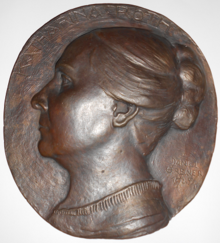Daniel Greiner
Daniel Greiner (born October 27, 1872 in Pforzheim ; † June 8, 1943 in Jugenheim ) was a Hessian artist and politician ( KPD Hessen ). He was a member of the Landtag of the People's State of Hesse in the Weimar Republic .
Life

Daniel Greiner was the son of a large family of preachers belonging to Jakob Friedrich Greiner and his wife Katharina Christine nee Elker. From 1896 to 1890 he attended the Grand Ducal Gymnasium in Worms. In May 1892 he enrolled at the University of Giessen and studied philosophy and Protestant theology. He completed his studies in 1896 with a doctorate as Dr. phil. from. The title of the doctorate was The Concept of Personality in Kant . From 1897 to 1901 he was rector and vicar in Schotten. In 1901 he came into conflict with the church leadership and resigned from the church and gave up his office in Schotten. He then studied at the Berlin sculpture school and in Paris. Then he worked as an artist in Schotten. A first exhibition in 1903 in the Darmstädter Kunsthalle paved his way to the Darmstadt artists' colony , of which he was a member from 1903 to 1906. In 1906 he left this colony and settled in Jugenheim, where he founded the Greiner and Guth tomb art workshop and the Felsberg publishing house . The workshop had over 30 employees at times. He published his extensive graphic work in the Felsberg publishing house.
Greiner worked as a sculptor , medalist , graphic artist and writer . The two-volume "Greiner Bible" named after him is his best known work. It consists of 147 woodcuts on subjects from the Old and New Testament. While his works of art were initially shaped by Art Nouveau , he later became a representative of expressive realism.
On March 14, 1897, he married Anna Lina Charlotte Emilie, née Suppes, in Schotten . The marriage resulted in ten children. Greiner lived with his large family for 37 years in the Drachenmühle at the entrance to the Stettbacher Tal near Jugenheim. During the National Socialist era he lived in isolation and material poverty.
Sculptures
- 1909: Peace fountain in Jugenheim.
- 1913: Siegfriedbrunnen , ceramic 46 × 47.5 cm at the old town hall in Jugenheim
Medals
- 1904/1905 100th anniversary of Schiller's death (May 8, 1905), two-sided, cast silver, 55 mm
- 1905 Persson, Nils Alfred, one-sided high oval hollow bronze cast, 306: 200 mm
- 1906 Bach, Johann Sebastian, one-sided cast bronze plaque, 80:74 mm
- Beethoven, Ludwig van
- Goethe, 235 mm
- 1906 Greiner, Daniel, self-portrait, cast bronze, 92 mm
- 1906 Knoth, Karl Ernst, cast bronze, 87 mm
- 1906 Merseburger, Katharina, cast bronze on one side, 79 mm
- 1906 Rembrandt, cast bronze, 80 mm, 300th anniversary of his birth
- 1913 Unknown man, one-sided oval bronze hollow casting, 117: 97 mm
politics
Daniel Greiner was a member of the KPD and until 1928 a member of the state parliament of the People's State of Hesse in Darmstadt . In 1924 he moved up to the state parliament as successor to Adam Heinrich Ebner . In the state election in 1924 he was then directly elected to the state parliament. In 1926 he campaigned for the foundation of the artist loan fund.
Honors
The Daniel Greiner Road in Darmstadt and the Daniel Greiner-way in Jugenheim were named after him.
Publications
- The concept of personality in Kant, Giessen 1896.
literature
- Daniel Greiner. In: Stadtlexikon Darmstadt . Stuttgart 2006, p. 324.
- Joseph August Beringer : Greiner, Daniel (Dr. phil.) . In: Ulrich Thieme , Fred. C. Willis (Ed.): General lexicon of visual artists from antiquity to the present . Founded by Ulrich Thieme and Felix Becker . tape 14 : Giddens-Gress . EA Seemann, Leipzig 1921, p. 588 ( Textarchiv - Internet Archive ).
- Hans Georg Ruppel, Birgit Groß: Hessian MPs 1820–1933. Biographical evidence for the estates of the Grand Duchy of Hesse (2nd Chamber) and the Landtag of the People's State of Hesse (= Darmstädter Archivschriften. Volume 5). Verlag des Historisches Verein für Hessen, Darmstadt 1980, ISBN 3-922316-14-X , p. 115.
- Hermann Weber , Andreas Herbst : German communists. Biographisches Handbuch 1918 to 1945. 2nd, revised and greatly expanded edition. Dietz, Berlin 2008, ISBN 978-3-320-02130-6 , p. 317 ( stiftung-aufverarbeitung.de ).
- Gerhard Beier : Labor movement in Hessen. On the history of the Hessian labor movement through one hundred and fifty years (1834–1984). Insel, Frankfurt am Main 1984, ISBN 3-458-14213-4 , p. 429.
- Camilla Hollstein: Daniel Greiner. In: Volk und Scholle. Vol. 6, issue 10.1928, pp. 308-314.
Web links
- Greiner, Daniel. Hessian biography. In: Landesgeschichtliches Informationssystem Hessen (LAGIS).
- Literature by and about Daniel Greiner in the catalog of the German National Library
- Works by and about Daniel Greiner in the German Digital Library
- Search for "Daniel Greiner" in the SPK digital portal of the Prussian Cultural Heritage Foundation
- Historical photographs of Daniel Greiner and his family
Individual evidence
- ↑ artist. Dr. Daniel Greiner. German Society for Medal Art, accessed on November 29, 2014 .
- ↑ Expressive dragon fight in FAZ from January 14, 2014, p. 44.
| personal data | |
|---|---|
| SURNAME | Greiner, Daniel |
| BRIEF DESCRIPTION | German artist and politician (SPD), member of the state parliament in the people's state of Hesse |
| DATE OF BIRTH | October 27, 1872 |
| PLACE OF BIRTH | Pforzheim |
| DATE OF DEATH | June 8, 1943 |
| Place of death | Jugenheim (Seeheim-Jugenheim) |

